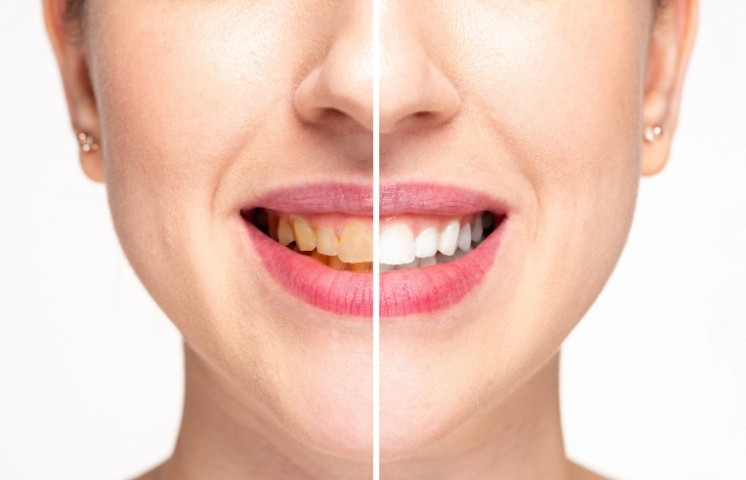$99 New Patient Special - Includes Exam and X-Rays.
How to Whiten Sensitive Teeth Naturally

By Dentist At Plum Creek Kyle
A radiant smile is a confidence booster, but what if you have sensitive teeth? Don’t worry, you can still achieve a whiter smile without the discomfort of harsh whitening treatments. This guide explores natural methods to whiten sensitive teeth, offering safe and effective ways to brighten your pearly whites.
Understanding Sensitive Teeth and Causes
A. What are Sensitive Teeth and Common Symptoms:
Sensitive teeth occur when the dentin, a layer beneath the enamel, becomes exposed. This exposure can cause sharp pains or twinges when you consume hot, cold, sweet, or acidic foods and drinks.
B. Factors Contributing to Tooth Sensitivity:
- Worn Enamel: Overbrushing, teeth grinding, and acidic foods can wear down enamel, exposing the dentin.
- Gum Recession: As gums recede, the root surface of the tooth becomes exposed, leading to sensitivity.
- Cracked Teeth: Cracks in teeth can allow hot or cold substances to reach the dentin, causing pain.
- Dental Procedures: Fillings, crowns, and other dental procedures can sometimes irritate nerves and cause sensitivity.
C. Impact of Tooth Sensitivity on Oral Health:
Sensitive teeth can make brushing and flossing uncomfortable, potentially leading to poor oral hygiene. This can increase your risk of cavities, gum disease, and other dental problems.
Gentle Whitening Techniques for Sensitive Teeth
A. Oil Pulling: A Traditional Remedy for Sensitive Teeth
Oil pulling, an ancient Ayurvedic practice, involves swishing oil in your mouth to remove toxins and whiten teeth. Coconut oil is a popular choice because of its antibacterial properties. Swish 1 tablespoon of coconut oil for 15-20 minutes daily before brushing.
B. Baking Soda and Hydrogen Peroxide: Safe Whitening Agents
When used correctly, baking soda and hydrogen peroxide can gently whiten teeth. Make a paste with 1 teaspoon of baking soda and a few drops of 3% hydrogen peroxide. Brush your teeth with this paste for 1-2 minutes, two to three times a week. Rinse thoroughly and follow with regular toothpaste.
Important Note: This method may increase sensitivity, so use it sparingly and discontinue if you experience discomfort.
C. Activated Charcoal: Natural Whitening Properties
Activated charcoal is a popular natural whitener. Brush your teeth with a toothpaste containing activated charcoal or dampen your toothbrush and dip it in powdered charcoal before brushing. Rinse thoroughly afterwards.
Dietary Changes for Whiter and Healthier Teeth
A. Importance of Calcium-Rich Foods for Dental Health
Calcium is essential for strong teeth. Include dairy products like milk, cheese, and yogurt in your diet. Leafy greens and tofu are also good sources of calcium.
B. Vitamin C-Rich Fruits for Stronger Enamel
Vitamin C helps maintain healthy gums and strong tooth enamel, which resists staining. Incorporate citrus fruits, strawberries, and bell peppers into your diet.
C. Avoiding Acidic and Sugary Foods to Prevent Sensitivity
Acidic and sugary foods can erode enamel and increase sensitivity. Limit acidic fruits like oranges and grapefruits, and sugary drinks and candies.
Home Remedies and Natural Treatments for Sensitive Teeth
A. Aloe Vera Gel: Soothing Relief for Sensitive Gums
Aloe vera gel has anti-inflammatory properties that can soothe sensitive gums. Apply a small amount of aloe vera gel to your gums and massage gently.
B. Green Tea Rinse: Anti-inflammatory Properties
Green tea contains antioxidants that can reduce inflammation and soothe sensitive teeth. Brew a cup of green tea, let it cool, and use it as a rinse after brushing.
C. Clove Oil: Natural Pain Reliever for Tooth Sensitivity
Clove oil has natural pain-relieving properties. Dilute one drop of clove oil with a carrier oil like coconut oil and apply a small amount to the sensitive tooth with a cotton swab. Be careful not to swallow.
Best Practices for Maintaining Whitened Teeth
A. Regular Brushing and Flossing to Prevent Stains
Brush your teeth twice daily with a toothpaste formulated for sensitive teeth and floss daily to remove plaque and prevent stains.
B. Using a Soft-Bristled Toothbrush for Sensitive Teeth
Harsh bristles can irritate sensitive teeth. Opt for a soft-bristled toothbrush and brush gently using a circular motion.
C. Consulting a Dentist for Professional Advice and Treatment Options
If you have persistent sensitivity, consult your dentist. They can identify the underlying cause and recommend professional whitening treatments suitable for sensitive teeth.
Conclusion
Achieving a brighter smile with sensitive teeth is possible! By adopting these natural methods, maintaining good oral hygiene, and consulting your dentist, you can enjoy a healthy, beautiful smile with confidence. Remember, consistency is key. Be patient and follow these tips to gradually whiten your teeth and keep them looking their best.
Here are some additional points to consider:
- Desensitizing Toothpastes: Look for toothpastes containing potassium nitrate, which can help block pain signals to the nerves in your teeth, reducing sensitivity.
- Sensitivity Relief Products: Over-the-counter gels and rinses containing ingredients like stannous fluoride can provide temporary relief from sensitivity.
- Professional Cleanings: Regular dental cleanings remove plaque and tartar buildup that can contribute to staining and sensitivity.
Remember: While these natural methods can be effective, they may take longer to show results compared to professional whitening treatments. Patience and consistency are key!
With a little effort and the right approach, you can achieve a whiter, healthier smile without compromising the comfort of your sensitive teeth. So brush up on these natural techniques, embrace a smile-friendly diet, and consult your dentist at Plum Creek Kyle for personalized advice on Teeth Whitening in Plum Creek Kyle. A radiant and pain-free smile is within reach!







